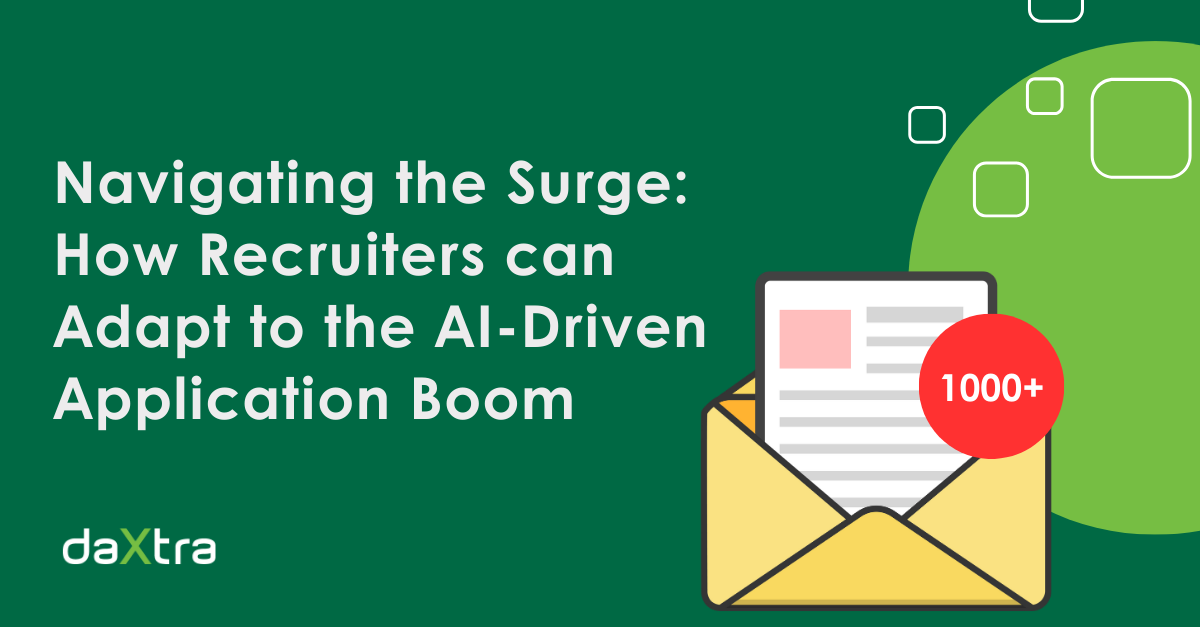By Ross Eaton
If you’re a Recruiter or Hiring Manager, chances are you’ve faced an overwhelming surge in job application volumes over the past year. Candidates (now equipped with tools such as job-board quick apply functions and AI-powered CV/resume tailoring at scale) can quite simply apply to more jobs – at an unprecedented scale.
Research published by Randstad in November 2024 shows that 57% of Gen Z jobseekers are using AI to write CVs, applications and cover letters (40% of Millennials, with Gen X and Baby-Boomers at 21% and 13%, respectively). Anecdotally, some sectors report application volumes increasing tenfold, leaving traditional hiring processes struggling to keep pace.
Shifting Dynamics
It almost feels wrong to complain, given all the work that goes into candidate attraction.
For years, hiring teams strived to increase visibility and engagement on job adverts – navigating ‘candidate-short’ markets as recently as 2022, or managing the ‘war for talent,’ which brought about cases of companies throwing a Tesla into the job offer, for candidates who may once have not been considered past first-stage screening.
Today, it seems that the pendulum has swung the other way. The influx of applications can obscure the line between quality and quantity, overwhelming hiring teams and their ability to ensure a good hiring experience – for both candidates and employers.
This shift in candidate dynamics has led to several challenges for recruiters.
Key Challenges from a Surge in Applications
1. Surfacing the Best Candidates
Ultimately, the goal of any hiring process is to fill the vacancy with the best candidate, as quickly as possible. In the period of having a ‘vacancy’ and the related reductions in output, and whilst your competitor also chases the best-matching skillset – it is imperative that you can quickly engage with the best candidate. But first, you have to find them.
Facing a flood of applications only makes finding the most suitable candidates more difficult. As the depth of applications recruiters need to wade through increases, so does the risk of missing exceptional talent.
Amid this challenge, the risk of bias creeping in increases, too, as recruiters can unconsciously lean on shortcuts to narrow down their options. Making hiring decisions under this kind of pressure and without careful consideration can also lead to an overall decline in the quality of hires.
2. Maintaining Candidate Experience
Ghosting has been the hot topic for a while, with recognition that any jobseeker who puts the effort into applying for your vacancy, deserves a response – whether than be a ‘yay or nay’. Not only can non-response leave applicants in an endless loop of the empty feeling of no success– but it also harms your employer brand. On the flip-side, a positive candidate experience, whether converting to hire or not, will often ripple across networks.
To ensure this positive candidate experience at scale, the impact of increased application volumes must be considered. Inevitably, candidate experience will be compromised if applications surge to unmanageable volumes. Alongside the potential damage to your employer reputation, missing the mark here is a missed opportunity to build connections with top talent.
Solutions to Manage Applications at Scale
As organizations embrace automation and AI, many have been strategizing on how to leverage technology to keep up (or at least, not fall behind).
Hiring teams, specifically, are looking for tech-powered solutions to manage the exponential growth of application volumes.
But just as candidates mass-apply using automation and AI-driven functions, hiring teams can also leverage technology to interact with candidates taking advantage of these tools . As it stands now, AI-driven application tools offer candidates significant benefits---employers can reap those benefits, too, to create a more efficient, mutually beneficial recruitment process.
Automated Engagement Tools enable recruiters to stay connected with applicants at scale, without the need for manual intervention at every stage. These tools can provide instant, perfectly timed updates, responses or next steps – allowing recruiters to focus their efforts on the most promising applicants.
Or, before we even get to that stage, applicants can be whittled down to show recruiters a shortlist of those identified as most suitable, by leveraging Applicant Tracking Systems’ (ATS) and candidate-processing solutions’ filtering capabilities, based on, for example, eligibility to work or skills. Then, you can utilise AI-driven Applicant Ranking, to assess and rank candidate suitability based on skills, experience and other key factors.
Whilst AI may not yet assess interpersonal dynamics perfectly, its ability to sort hundreds of candidates by hard skills offer huge time-saving benefits nonetheless.
Looking wider, we’re seeing success at both ends of the spectrum with optimised job descriptions, (e.g., clearly outlining basic requirements, desired skills and qualifications). These are the bread-and-butter of attracting more relevant candidates and reducing volumes of less qualified applicants.
Plus, those at the leading edge of recruitment tech have experimented with AI bots/screening agents, now seen as staples in some employers’ recruitment process, to filter out unsuitable candidates without the need for manual intervention.
AI: The Future of Effective Hiring
The widespread use of AI in job applications isn’t showing any signs of slowing down. As candidates adopt these tools to level the playing field, recruiters and hiring managers must also leverage AI and automation to keep up – and be enabled to make fast, smart hiring decisions.
Looking to add AI into your recruiting workflows? Get in touch with our team to learn how Daxtra can help you search, match and engage with top talent, fast.



